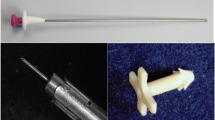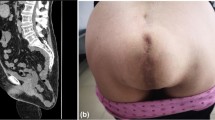Abstract
Background
Bone anchoring systems are used extensively in orthopaedic surgery but have scarcely been reported as useful in abdominal wall or perineal hernia repair. After coccygectomy or sacrectomy the development of bowel herniation is not uncommon. Considering repair of such a perineal hernia, adequate fixation of the prosthetic mesh is difficult and, therefore, recurrence is rather frequent, mostly due to insufficient anchoring of the mesh to the bony structures.
Methods
We discuss a patient in which the Mitek GII anchoring system was used to overcome the problem of soft-tissue-to-bone attachment in such cases.
Conclusion
Bone anchoring systems seem to be an efficient method to overcome the problems of soft-tissue-to bone attachment in both abdominal and perineal hernia repair.





Similar content being viewed by others
References
Santora TA, Kaplan LJ, Sherk HH (1998) Perineal hernia: an undescribed complication following sacrectomy. Orthopedics 21:203–205
Garcia FJ, Franco JD, Marquez R, Martinez JA, Medina J (1998) Posterior hernia of the rectum after coccygectomy. Eur J Surg 164:793–794
Frydman GM, Polglase AL(1989) Perineal approach for polypropylene mesh repair of perineal hernia. Aust N Z J Surg 59:895–897
Villar F, Frampas E, Mirallie E, Potiron L, Villet R, Lehur PA (2003) Perineal incisional hernia following rectal resection. Diagnosis and management. Ann Chir 128:246–250
Luijendijk RW, Hop WC, van den Tol MP, de Lange DC, Braaksma MM, et al (2000) A comparison of suture repair with mesh repair for incisional hernia. N Engl J Med 343:392–398
Rehak DC, Sotereanos DG, Bowman MW, Herndon JH (1994) The Mitek bone anchor: application to the hand, wrist and elbow. J Hand Surg [Am] 19:853–860
Hom D, Desautel MG, Lumerman JH, Feraren RE, Badlani GH (1998) Pubovaginal sling using polypropylene mesh and vesica bone anchors. Urology 51:708–713
Fergestad J, Noonan KJ, Mack E (2003) An innovative approach for repair of complex inguinal and abdominal wall hernias. J Am Coll Surg 197:1050–1052
Rossouw DJ, McElroy BJ, Amis AA, Emery RJ (1997) A biomechanical evaluation of suture anchors in repair of the rotator cuff. J Bone Joint Surg Br 79:458–461
Enzler M, Agins HJ, Kogan M, Kudurna J, Sand P, Wurtz R, Culligan P (1999) Osteomyelitis of the pubis following suspension of the neck of the bladder with use of bone anchors: a report of four cases. J Bone Joint Surg Am 81:1736–1740
Author information
Authors and Affiliations
Corresponding author
Rights and permissions
About this article
Cite this article
Berrevoet, F., Pattyn, P. Use of bone anchors in perineal hernia repair: a practical note. Langenbecks Arch Surg 390, 255–258 (2005). https://doi.org/10.1007/s00423-004-0523-6
Received:
Accepted:
Published:
Issue Date:
DOI: https://doi.org/10.1007/s00423-004-0523-6




